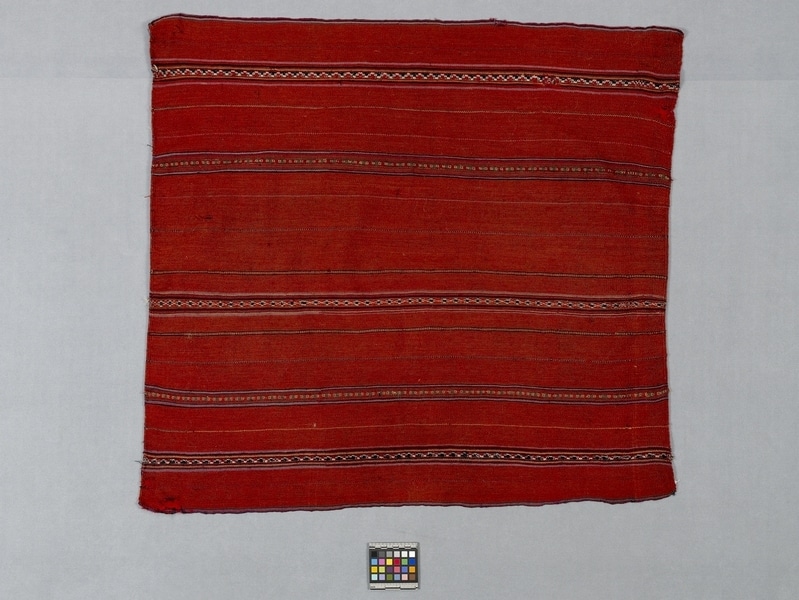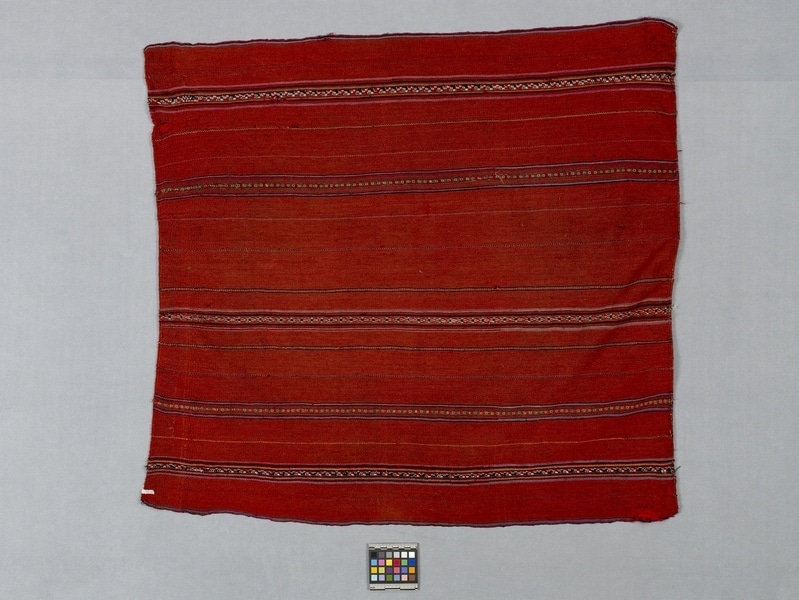Cloth Item Number: Sf392 from the MOA: University of British Columbia


Description
A rectangular red-brown cloth with five major groupings of stripes and geometric patterned bands, and 11 singular stripes. Yellow squares on an alternating red and green background appear in two bands. Opposed red and blue triangles, separated by a white zigzag, appear in two bands. Blue diamonds on a red background with a white outline appear in the fifth band.
History Of Use
Warp-faced fabric with three or four selvedges are woven by women but the fabrics are used by men and women. The techniques, structures and some of the motifs have pre-Conquest antecedents. This type of textile conveys the most information about an individual's ethnicity, sex, age, status and particular history. Rectangular cloths with motifs are used by women as carrying cloths and shoulder covers. The lliklla used today is black with fine red stripes and is a larger cloth made of 2 loom widths. Striped cloths of single loom widths today are called 'istalla' and are used for carrying daily food or coca and ritual offerings at weddings and at the paying of Pachamama (the earth). This single width cloth is larger than contemporary 'istalla', but smaller than 'lliklla', although the Taquile people who saw it called it lliklla.
Specific Techniques
Sheep's wool is spun z and plied 2-s. Some of the fine threads in the stripes appear to be alpaca, also z-2's. The fabric is warp-faced plain weave. The motifs are in a float weave derived from a turned 2/1 herringbone. The complete cloth is one 4 selvedge fabric. The dyes appear to be natural ones. Possible sources: 'chapi' with 'llacre' for red-brown (roof of a bush with iron rich rocks); flower of solina for yellow; nuleca (root of a plant) for purple.
Iconographic Meaning
The motif of opposed stepped triangles is called 'fadma' (ruins, archaeological). The outlined diamond is called 'hatun cruz' (large cross). The constellation of the Southern Cross is also called hatun cruz. The motif with squares is often referred to as 'Estrella del camino de los Incas' or 'Star of the Inca road.'
Narrative
Bought in the Cooperativo Artesanal Manco Capac Taquile, from Cesar Huatta Cruz. He said it was made 50 years ago and used by his grandmother, Francisca Quispe Cruz, who is now dead. Although Cesar's information may be suspect, it is likely to have been made in Taquile, or on nearby Amantani. A cloth of similar size, colour and stripes is in the Taquile Museo Artesanal. Many Taquilenos looked at it and offered information on the designs and dyes. Other people estimated the age to be 40 or 50 years.
Item History
- Made by Francisca Quispe Cruz ? (Maker) in Taquile, Puno, Peru between 1910 and 1950
- Collected by Mary Frame during October 1987
- Owned by Mary Frame before November 3, 1987
- Received from Mary Frame (Seller) and Museum of Anthropology Shop Volunteers (Funding source) on November 3, 1987
What
Who
- Culture
- Quechua
- Creator
- Francisca Quispe Cruz ? (Maker)
- Field Collector
- Mary Frame
- Previous Owner
- Mary Frame
- Received from
- Mary Frame (Seller) and Museum of Anthropology Shop Volunteers (Funding source)
Where
- Holding Institution
- MOA: University of British Columbia
- Made in
- Taquile, Puno, Peru
When
- Creation Date
- between 1910 and 1950
- Collection Date
- during October 1987
- Ownership Date
- before November 3, 1987
- Acquisition Date
- on November 3, 1987
Other
- Item Classes
- textiles
- Condition
- good
- Accession Number
- 1274/0004